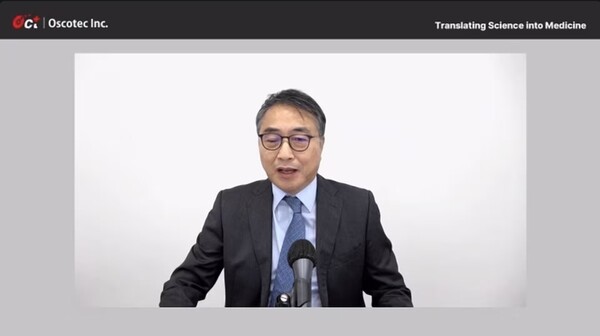Oscotec’s plan to take its U.S.-based subsidiary Genosco public is under fire. Five months after filing for a Kosdaq listing, the biotech behind lazertinib—Korea’s first FDA-approved oncology drug—faces regulatory delays and growing investor backlash.
Some investors argue the IPO is less about growth and more about benefiting insiders.
At the center of the controversy is Oscotec CEO James Kim, who is fighting to justify the IPO ahead of his March 27 reappointment vote. During an investor briefing Wednesday, he acknowledged that his son holds a 13 percent stake in Genosco, a disclosure that has only intensified scrutiny.
But without the IPO, Kim warned, Genosco could run out of cash, jeopardizing its research operations and dragging down Oscotec’s valuation.
“If Genosco fails to list, there’s a 90 percent chance the research center will shut down,” he said during the online briefing.

Oscotec CEO James Kim says Genosco needs an IPO to survive. Investors aren’t buying it, calling it a spin-off play in a Wednesday Zoom briefing. (Credit: Korea Biomedical Review)
Regulators are reviewing whether Genosco’s IPO constitutes a duplicate listing, given its financial entanglement with Oscotec. The two companies co-developed lazertinib (sold as Leclaza by Yuhan Corp.) and share revenue through licensing agreements with Johnson & Johnson (J&J) and Yuhan.
For investors, the IPO looks more like a reshuffling of assets than a move that generates real value. One institutional shareholder, commenting during the briefing, pointed to the intertwined revenue structure. "Lazertinib was developed by Genosco, but the money still flows through Oscotec, Yuhan, and J&J. If the financials remain linked, what’s the point of a separate listing?"
Oscotec has been funneling cash into Genosco’s R&D for years, raising further concerns. Given that Oscotec has 1.1 trillion won ($759 million) in cash reserves and steady lazertinib royalties, investors are questioning the necessity of the IPO.
Kim insists that Genosco needs its own funding to sustain drug development, rather than relying on Oscotec’s balance sheet. Royalties from lazertinib won’t peak for at least 26 months, and by then, new competitors could emerge. "We can’t afford to wait," he said.
The key argument? Oscotec and Genosco have distinct R&D strategies. Oscotec is focused on ADEL-Y01, an Alzheimer’s drug currently in a U.S. phase 1 trial, while Genosco is advancing kinase inhibitors and targeted protein degradation (TPD) platforms.
Talks with multinational pharma companies on an ADEL-Y01 licensing deal have been ongoing since last year, with an agreement expected within 2025. Once patient dosing begins, Kim suggested, serious offers would follow.
Other pipeline assets include OCT-598, an immuno-oncology candidate licensed from Korean biotech Kanaph Therapeutics, which is set to enter clinical trials this year with preclinical results to be presented at AACR next month, and OCT-648, a cardiovascular drug expected to begin trials next year.
Some investors have called for a full merger of Oscotec and Genosco rather than a spin-off, but Kim ruled it out as legally and financially impractical. Merging a Korean and a U.S. company isn’t legally possible, he said, and structuring it as a triangular merger would come with prohibitive legal and tax costs.
A Nasdaq listing was also considered and ultimately dismissed. Kim said Oscotec spent years evaluating the option, but the costs of listing and compliance—ranging from tens to hundreds of billions of won—made it unrealistic for a mid-sized biotech.
To ease investor concerns, Oscotec has proposed distributing up to 20 percent of Genosco’s IPO shares as a stock dividend to existing shareholders, a move intended to balance capital raising with direct shareholder benefits.